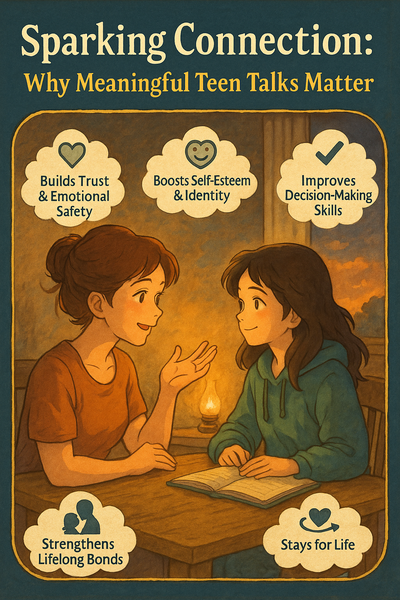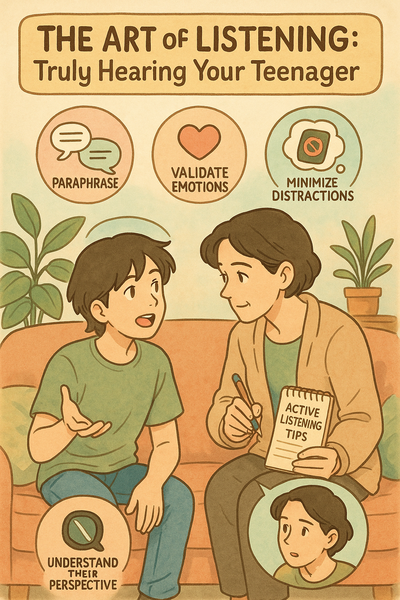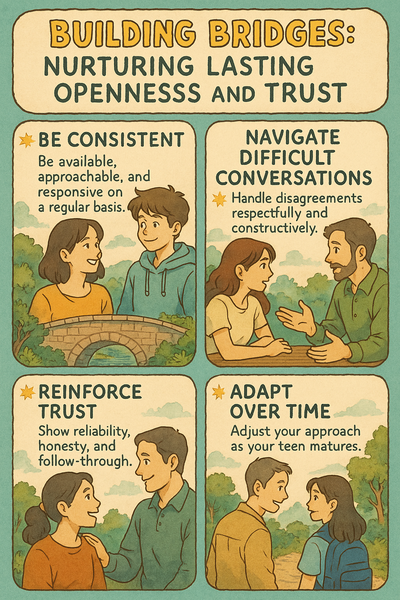Beyond One-Word Answers: How to Spark Meaningful Conversations with Your Teen

Tired of getting “fine” or “okay” from your teen? Discover effective strategies to foster open, honest, and deeper communication with your teenager and build lasting connection.
Introduction
The familiar scene: a parent asks their teenager about their day, hoping for a glimpse into their world, only to be met with a curt "fine," "okay," or a noncommittal shrug. This common parental frustration can lead to feelings of disconnect and concern. However, there is hope. Meaningful conversations with teenagers are not a lost art; they are possible with the right understanding and strategies. This exploration aims to unlock the secrets to better communication by delving into why teens often communicate with brevity and how parents can cultivate an environment ripe for deeper, more fulfilling connections.
Section 1: The "Fine" Line: Why Your Teen Gives One-Word Answers
Understanding that a teenager's concise communication style is often a normal, albeit sometimes exasperating, part of their journey to adulthood can foster parental empathy. These brief responses are frequently less about outright defiance or a lack of care and more about complex developmental shifts.

1.1. It's Not Just You: Understanding the Teen Brain and Development
The teenage years are a period of profound transformation, not just physically but also neurologically and socially. These changes significantly impact how adolescents interact with the world, including their parents.
- The Drive for Autonomy: A central developmental task for adolescents is the establishment of independence and the formation of their own identity, distinct from their parents. This quest for autonomy is a healthy and essential process for becoming a self-sufficient adult. As adolescents mature, they increasingly desire to make their own decisions about personal matters, such as their appearance and friendships. This burgeoning desire for self-determination can sometimes lead to changes in communication with parents, making caregivers feel pushed away, particularly during early to mid-adolescence. Teens might question parental rules, seek more privacy, or express strong preferences in areas like clothing and music as they work through this developmental milestone to "self-govern and become self-sufficient adults". When parents understand this fundamental drive, they can reframe seemingly dismissive behavior. A one-word answer might not be a personal rejection, but rather a teen's attempt to assert their growing independence and control over their own communication. This perspective allows parents to respond with less frustration and more understanding, focusing on maintaining connection in ways that respect this developmental need.
- Shifting Social Worlds & Peer Influence: During adolescence, the importance of peer relationships skyrockets. Acceptance by a peer group becomes crucial, often influencing how teens think, speak, dress, and behave as they strive to belong. Consequently, teenagers may reserve their more detailed and enthusiastic communication for their friends as they navigate social acceptance and group dynamics. Studies show that from childhood to adolescence, there's a general increase in the tendency for youth to conform to the perspectives of their peers, especially when parents and peers offer conflicting advice. This shift in focus doesn't mean parents are no longer important. However, the teen's social energy and primary communication efforts might be temporarily redirected towards their peer group as they practice new social roles and seek validation within their age cohort. This natural part of individuation can manifest as briefer responses to parents.
- Cognitive Development & Abstract Thinking: Adolescents experience significant cognitive growth, developing the capacity for more abstract thought. They become increasingly concerned with broader, more complex issues such as philosophy, politics, and social justice. This cognitive maturation means their internal world is becoming richer and more intricate. While this development allows for deeper conversations , these might not always be directed at parents initially. Teens might be internally processing new ideas, forming their own opinions, and may feel vulnerable sharing these nascent thoughts, especially if they anticipate misunderstanding or judgment. If past interactions have involved quick dismissal of their ideas, they may opt for silence or brief answers to avoid perceived criticism, reserving their more elaborate discussions for environments they perceive as safer or more accepting.
1.2. The Psychology Behind the Silence: Beyond Development
Beyond the broad developmental changes, specific psychological factors also contribute to why teenagers might offer only minimal responses.
- Boredom with Repetitive Questions: One straightforward reason for terse replies is that teens may simply be tired of predictable, repetitive questions. The classic "How was your day?" can feel uninspired and may not genuinely invite a detailed response. As Dr. Konishi noted, children might find such standard questions "BORING," which is why they don't inspire more than a one-word answer. This suggests that a simple adjustment in questioning style could yield more engagement.
- Feeling Unheard or Anticipating Negativity: Past communication experiences heavily influence current interactions. If teenagers feel that their parents are not truly listening—perhaps because they are multitasking or seem distracted—they may be reluctant to elaborate. Furthermore, if previous conversations have frequently devolved into lectures, nit-picking, or criticism, teens may learn to offer minimal responses as a defensive strategy. This pattern emerges when a teen consistently experiences conversations as a means for parents to extract information, correct behavior, or impose their views. The teen learns that engaging more deeply leads to more of what they wish to avoid. One-word answers then become an efficient strategy to fulfill the conversational obligation without opening the door to these negative experiences. This is not just about the current conversation but a learned response based on a history of interactions; the teen isn't merely "being difficult" but is actively employing a learned coping mechanism.
- Emotional Overwhelm or Lack of Processing Time: Adolescence is often a period of intense emotions. Teens may not always possess the vocabulary or the emotional readiness to discuss what they are feeling, particularly in the heat of the moment. Silence or brief answers can be a way for them to manage these powerful feelings or to buy time for internal processing. Pressuring a teen to talk when they are not ready can be counterproductive, potentially leading them to withdraw further.
- Testing Boundaries: As part of their journey towards autonomy, teenagers may use brief answers as a way to test parental reactions and assert a degree of control over interactions. This can be a subtle form of demonstrating their independence, by questioning or even passively resisting the conversational expectations set by parents. A monosyllabic answer can serve as a low-conflict way for a teen to signal a need for space, a different approach from the parent, or that the parent's current communication strategy is proving ineffective. It can be a subtle cue indicating boredom , a feeling of being unheard , or simply that the teen is not in the right frame of mind to talk. Parents can learn to interpret these cues as valuable feedback rather than just frustrating roadblocks, prompting a shift in their own conversational tactics.
Section 2: Unlocking the Vault: Secrets to Meaningful Teen Conversations
While the reasons for one-word answers are multifaceted, parents possess more influence than they might realize in fostering richer dialogue. Transitioning from understanding the "why" to implementing actionable "how-to" strategies can transform communication dynamics.

2.1. Laying the Foundation: Creating a Safe and Open Environment
Before specific communication techniques can be effective, essential groundwork must be in place. This involves cultivating a relational context where teenagers feel secure, respected, and genuinely heard.
2.1.1. The Underrated Power of Active Listening: Truly Hearing Them
Active listening is far more than simply remaining silent while another person speaks; it involves tuning into their underlying thoughts and feelings. It powerfully communicates care and genuine interest, which can strengthen communication and improve the parent-teen relationship. When teens feel truly heard, they are more likely to open up and share more deeply. Key techniques include:
- Giving full attention: This means putting aside distractions like phones or other tasks, signaling that the teen is the priority.
- Allowing them to talk without interruption: Resist the urge to jump in with questions or comments that break their train of thought.
- Using encouraging non-verbal cues: Simple actions like nodding, maintaining appropriate eye contact, and adopting open body language (e.g., turning towards them, uncrossed arms) convey engagement.
- Showing interest with brief affirmations and clarifying questions: Verbal cues like "I see," or "That sounds tricky," and asking open-ended questions like "And then what happened?" during a natural pause, demonstrate active involvement.
- Summarizing their words and feelings: Rephrasing what they have said (e.g., "So, it sounds like you're feeling frustrated because...") confirms understanding and shows that their message has been received accurately. This act of reflecting back often serves as an invitation for them to elaborate further.
2.1.2. Empathy is Your Superpower: Validating Their World
Empathy in parent-teen communication involves striving to understand their perspective and feelings, even when those differ from one's own or when one doesn't necessarily agree with their viewpoint. It's crucial to acknowledge and validate their emotions by saying things like, "I can see you're really upset about this," or "It sounds like that was a really difficult experience for you," rather than dismissing or minimizing their feelings. Parents should resist the common urge to immediately jump into "fix-it" mode; often, teens are not looking for solutions but simply for understanding and validation. Recalling one's own teenage years and the intensity of adolescent experiences can help parents connect with what their teen might be going through. Empathy builds strong connections, making teens feel safe and supported, which in turn encourages them to share their vulnerabilities.
2.1.3. Building Bridges of Trust: The Importance of Non-Judgmental Communication
A non-judgmental stance is foundational to trust. It means listening without immediately criticizing, imposing personal views, or jumping to conclusions. Parents should avoid using labels or making generalizations about their teen's character. Instead, focusing on observing and describing specific behaviors (e.g., "I noticed your homework isn't started yet") rather than making character judgments (e.g., "You're so lazy") can make a significant difference. This approach helps create a safe space where teens feel they can share mistakes, differing opinions, or sensitive information without fear of condemnation or harsh judgment. If teens anticipate judgment, they will be far less likely to be honest or to share significant concerns.
The cultivation of active listening, empathy, and non-judgmental communication is not about mastering isolated skills but about fostering a holistic approach. These qualities are deeply interconnected and mutually reinforcing. For instance, one cannot truly listen actively if simultaneously formulating a judgmental rebuttal. A lack of empathy will likely lead to responses that feel critical, undermining any attempts at active listening. Therefore, parents need to develop these three pillars in concert to create a genuinely safe and open communicative environment. This, in turn, requires significant emotional self-regulation from the parent. To listen without interrupting when a teen says something provocative, to respond with empathy when feeling frustrated, or to describe behavior non-judgmentally when internally alarmed, parents must first manage their own emotional reactions. A crucial "secret" to better communication with teens, therefore, lies in parents working on their own emotional intelligence and reactivity.
2.2. Crafting Connection: Smart Communication Strategies
With a foundation of safety and trust, parents can employ specific strategies to initiate and sustain more meaningful conversations.
2.2.1. Beyond "How Was Your Day?": The Art of Asking Open-Ended & Creative Questions
Standard, closed-ended questions often elicit one-word answers because they are predictable and don't require much thought. Open-ended questions, in contrast, necessitate more than a simple "yes" or "no" response. They typically begin with words like "what," "how," "why," or phrases such as "tell me about...". Asking different, specific, and creative questions signals genuine interest and can make conversations more engaging. Examples include:
- Regarding school: "What was the most interesting (or challenging) idea you encountered in any of your classes today?"
- About friendships: "What are some of the qualities you value most in your friends?"
- Concerning interests: "If you could create any kind of app or video game, what would it be about and what would make it unique?"
- Exploring feelings: "What's something that made you laugh or feel good today?" or "Tell me about a time you felt really proud of how you handled something."
- Using creative/hypothetical scenarios: "If you could have a conversation with any historical figure, who would you choose and what would you ask them?"
2.2.2. Timing is Everything: Choosing the Right Moment and Approach
The timing and context of a conversation attempt can significantly impact its success. It's generally unwise to try and initiate deep discussions when either the parent or the teen is tired, stressed, distracted, or rushing. Instead, parents should look for natural openings, such as during car rides, while engaging in a shared activity, or during quieter moments like before bed. It's also important to be prepared for spontaneous conversations, as teens often choose to open up on their own timetable, not necessarily when it's most convenient for the parent. Phrases like "Let's talk" can inadvertently put teens on the defensive, as they may anticipate a lecture or confrontation. A more casual, less demanding approach is often more effective.
2.2.3. Share Your World (Appropriately): The Impact of Parental Vulnerability
Sharing age-appropriate personal struggles, experiences, or feelings from one's own adolescence can make parents more relatable and human in the eyes of their teens. This can help teenagers see their parents not just as authority figures but as individuals who also navigated the complexities and challenges of growing up. Such self-disclosure can normalize the teen's own experiences and foster a sense of shared humanity, thereby deepening trust. However, it's important to exercise caution: the goal is connection, not a parental monologue. Oversharing or consistently turning the conversation back to oneself can be counterproductive.
2.2.4. Finding Common Ground: Connecting Through Shared Interests & Lighter Topics
Not every conversation needs to be profound or centered on problems. Engaging in lighthearted chat about topics that genuinely interest the teen—such as their favorite music, movies, games, hobbies, or friends—builds rapport and comfort. Participating in activities they enjoy, or discovering new shared interests like visiting museums, going on outdoor adventures, taking a class together, or volunteering for a common cause, can also strengthen the bond. These positive, low-pressure interactions create a reservoir of goodwill and trust, making it easier to broach more sensitive or challenging subjects when the need arises.
2.2.5. Tech-Free Time: Making Intentional Space for Real Connection
The pervasive nature of technology can sometimes hinder face-to-face communication, as digital interactions may curtail the nonverbal cues crucial for developing social skills. Establishing "tech-free zones" or specific times—such as during meals or for an hour before bedtime—can encourage more direct, present interaction. Engaging in offline activities together, like playing board games, taking walks, or cooking, provides opportunities for undistracted conversation and connection. This dedicated unplugged time allows for richer, more nuanced communication that includes body language and tone of voice, fostering deeper understanding.
2.2.6. Respecting Their Growing Independence: Boundaries and Privacy
Acknowledging and respecting a teenager's increasing need for autonomy and privacy is crucial as they mature. This can involve allowing them more freedom in personal domains like clothing choices, hairstyle, and room décor, and including them in family decision-making processes where appropriate. While respecting their privacy is important, parents must also maintain open lines of communication and ensure their teen's safety, which includes knowing essential information like their whereabouts. When parents respect their teen's developing autonomy, it fosters trust and signals that they are seen as capable individuals. This, in turn, can make teens more willing to communicate openly and honestly.
The effectiveness of these communication strategies is greatly amplified when they are used in combination, rather than in isolation. For example, asking a well-crafted open-ended question is beneficial, but its impact is magnified when posed at an opportune moment, in a tech-free environment, and when the parent responds with active listening, empathy, and a non-judgmental attitude. Similarly, many of these approaches encourage a shift from primarily reactive communication (addressing problems only as they arise) to proactive communication (consistently building the relationship and fostering openness as an ongoing practice). Proactive efforts, such as regularly finding common ground or scheduling one-on-one time, build relational capital that proves invaluable when more challenging, reactive conversations become necessary.
2.3. Navigating the Bumps: Handling Communication Challenges Effectively
Even with the best intentions and strategies, communication challenges will arise. Knowing how to manage these difficulties and avoid common missteps is key.
2.3.1. Recognizing and Sidestepping Common Communication Traps
Awareness is the first step to avoiding behaviors that shut down dialogue. Parents should be mindful of these common pitfalls:
- Lecturing or Preaching: Teens often tune out when they feel they are being talked at rather than with. Instead of a lengthy speech about irresponsibility after a missed curfew, a parent might try: "I noticed you came home late. Can you tell me what happened?".
- Rapid-fire Questions: Bombarding a teen with too many questions can make them feel interrogated and become defensive. Instead of: "Why did you skip school? Don't you care about your grades?!", a calmer approach is: "I heard you missed school today. What's going on?".
- Overreacting: Extreme emotional responses or immediate harsh punishments can make teens hesitant to share future problems. It is better to stay calm and listen before reacting.
- Dismissing or Minimizing Feelings: This invalidates a teen's experience and can make them feel misunderstood or unimportant. Instead of saying, "It's not a big deal," try validating their emotion: "I can see that you're really upset about this".
- Making It About Yourself: Shifting the conversation to the parent's own experiences or feelings takes the focus off the teen. The aim should be to keep the focus on them by listening and asking thoughtful questions.
- Criticizing, Blaming, or Labeling: Such language damages a teen's self-esteem and erodes trust. It is important to focus on the specific behavior, not their character. For example, instead of "You're so lazy for not studying," one could say: "I see you're finding math challenging. What do you think might help you feel more prepared for the next test?".
- Solving Too Quickly or Giving Unsolicited Advice: Jumping in to fix problems robs teens of the opportunity to develop their own problem-solving skills and can make them feel incapable. It is more helpful to ask for their thoughts and guide them toward their own solutions.
- Bringing Up Past Mistakes: Rehashing old issues can make teens feel like they can never move forward or that they are constantly judged by their past. The conversation should remain focused on the current situation.
- Ignoring Non-Verbal Cues: Overlooking signs that a teen is upset, uncomfortable, or disengaged can make them feel invisible or unheard. Paying attention to body language and tone of voice is crucial.
- Engaging in Power Struggles: Turning disagreements into battles for control often leads to increased resistance from teens. Collaborative problem-solving and offering choices when appropriate can be more effective.
- Comparing Them to Others: Comparisons with siblings or peers can be very damaging to a teen's self-worth and individuality. The focus should be on their unique strengths and journey.
- Pointing Out Their Insecurities: Highlighting areas where a teen already feels vulnerable is deeply hurtful and can be perceived as bullying. Offering support and understanding is far more constructive.
Engaging in these communication traps often creates a negative feedback loop: a parent's unhelpful behavior elicits more of the teen's undesired response (like silence or defiance), which then tempts the parent to resort to even more ineffective strategies. Breaking this cycle requires the parent to consciously choose a different, more constructive response, even when feeling frustrated. Furthermore, many of these traps stem from a parent's own anxieties, fears, past experiences, or a desire for control. Recognizing these internal drivers is a crucial step toward change, allowing parents to pause and choose responses that are more attuned to their teen's needs rather than their own immediate emotional reactions or agendas.
2.3.2. When Silence Signals Something More: Knowing When to Seek Professional Help
While some withdrawal and communication shifts are normal during adolescence, persistent and marked changes can indicate more serious underlying issues. Parents should be alert to red flags such as:
- Prolonged and severe withdrawal from family and friends.
- Persistent hostility, anger, or irritability.
- Significant changes in friends, sleep patterns, or eating habits.
- Talk of self-harm or suicide.
- Signs of substance abuse.
- Indications of trauma, such as bullying or abuse.
If parents observe such concerning signs or have a persistent gut feeling that something is seriously wrong, it is important to trust those instincts and seek professional help from a qualified clinician, therapist, or counselor. Early intervention can be critical for addressing mental health issues like depression, anxiety, or other conditions that can emerge during the teen years.
Section 3: The Long Game: Nurturing a Lifelong Connection
Improving communication with a teenager is not about achieving a quick fix; it's about playing the long game and nurturing a bond that can adapt and strengthen over time.

3.1. Patience, Persistence, and Positive Reinforcement
Building, or rebuilding, strong communication with a teenager is an ongoing process that requires considerable patience and persistence. There will inevitably be good days and bad days in terms of connection and conversation. It's important for parents not to become discouraged by setbacks or periods of silence. Consistently applying positive communication strategies, even when immediate results aren't apparent, is key. When a teen does share, open up, or communicate effectively, acknowledging and affirming this behavior can be very powerful. Simple statements like, "Thank you for sharing that with me," or "I really appreciate you telling me about that," can build their confidence and encourage more of the same positive behavior in the future. Parents should also remember they are not alone in facing these challenges; many others navigate similar experiences.

3.2. Celebrating Small Wins in Communication
In the journey of fostering deeper conversations, it's important for parents to notice and appreciate even small improvements. A slightly longer answer than usual, a spontaneously shared thought, a moment of shared laughter, or a comfortable silence during a shared activity can all be signs of progress. These small wins are significant; they indicate that efforts are making a difference and can motivate both the parent and the teen to continue building their connection. The focus should be on the quality of the connection and the feeling of being understood, rather than simply the quantity of words exchanged. Recognizing and valuing these incremental steps helps maintain momentum and hope, reinforcing the idea that the efforts invested are indeed worthwhile.
The overarching goal of these efforts is not to revert to the communication style of early childhood but to develop a new, age-appropriate way of connecting that respects the teenager's growing maturity and independence while maintaining essential parental support and guidance. This is about laying the foundation for a resilient relationship that can adapt through adolescence and into adulthood. Furthermore, by consistently modeling active listening, empathy, non-judgmental communication, and constructive conflict resolution, parents are doing more than just improving their current relationship; they are also equipping their teens with vital communication and relational skills that they will carry into their own future adult relationships. This "long game" is therefore not just about the parent-teen dynamic but about preparing the teen for a lifetime of healthy connections.
Conclusion
Moving beyond one-word answers from teenagers is a journey, not a destination—a journey that has the profound potential to strengthen the parent-teen bond for years to come. It requires understanding the complex developmental and psychological reasons behind their communication styles, from their innate drive for autonomy to their shifting social worlds and the emotional intensity of adolescence. By consciously laying a foundation of trust through active listening, empathy, and non-judgmental communication, parents create a safe harbor where teens feel more willing to share their inner worlds.
Employing smart communication strategies—such as asking creative, open-ended questions, choosing the right moments, sharing appropriately, finding common ground, and making intentional space for tech-free connection—can unlock deeper dialogues. Equally important is the awareness and avoidance of common communication traps that can inadvertently shut down conversations. While patience and persistence are paramount, celebrating small victories along the way can provide encouragement for both parent and teen. Ultimately, by applying these "secrets" with consistent effort and genuine love, parents can cultivate not just more words, but more meaningful, lasting conversations and a resilient connection with their teenagers as they navigate the path to adulthood.
FAQs About Meaningful Conversations with Teens: Building Trust, Connection & Confidence
- Question:
Why do teenagers often give one-word answers? - Answer:
Teenagers may resort to one-word answers because they feel overwhelmed, unsure how to express themselves, or believe their parents won’t understand. It can also be a sign they want independence or are testing boundaries. Building trust and showing genuine interest can help them open up. - Question:
How can I start a meaningful conversation with my teen? - Answer:
Start by asking open-ended questions like “What was the best part of your day?” or “How are you feeling about school lately?” Choose calm, pressure-free moments—like during a walk or car ride—and focus on listening more than talking. - Question:
What if my teen doesn’t want to talk? - Answer:
Respect their space while gently reminding them you're available. Avoid forcing conversations. Keep showing interest in their life, and when they do speak, respond with empathy and without judgment to build trust over time. - Question:
How do I create a safe space for open communication? - Answer:
A safe space means no judgment, criticism, or overreaction. Be present, listen actively, validate their feelings, and avoid lecturing. Let them know they can talk to you about anything, and you’ll support them even if you don’t always agree. - Question:
Can sharing my own experiences help my teen open up? - Answer:
Yes, sharing age-appropriate personal stories can help your teen feel less alone and more understood. It shows vulnerability and builds connection, making it easier for them to trust you with their own challenges.

Comments
No comments yet. Be the first to leave a comment!